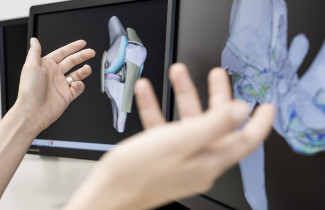Experimental and clinical studies have been complemented with computational models to overcome limitations such as high cost, difficulties in obtaining accurate measures, and limited understanding of the biomechanical response of the knee joint. Published in Scientific Reports, a new study from the University of Eastern Finland shows that, thanks to a new numerical approach, simpler material models of ligaments with similar properties in compression and tension can be used when the loading is directed primarily along the ligament axis in tension. A numerical knee model which considers geometric and material nonlinearities of meniscus and cartilages was able to predict the effect of different representations of ligaments on joint reaction forces throughout the stance phase.
The study used five different constitutive models for the ligaments (spring, elastic, hyperelastic, porohyperelastic, and fibril-reinforced) to evaluate their influence on knee response during the stance phase of gait. Knee joint forces for the models with elastic, hyperelastic and porohyperelastic properties showed similar behaviour throughout the stance, while the model with fibril-reinforced properties showed lower joint forces during the last part of the stance phase. The results also showed the fibril network contributed substantially to the knee joint forces, while the nonfibrillar part and fluid had minimal effects.
In the knee joint, the stability is provided by different structures such as ligaments, menisci, and muscles, which exhibit a complex mechanical response and affect the articular cartilage response under different loading conditions. In particular, ligaments play an important role in providing stability as well as restraining knee joint during daily activities. However, the contributions of the ligaments and their structural constituents are not well known. Research on the effect of these ligament properties might contribute to understanding joint disorders and improve medical rehabilitation protocols after knee injuries.
Computational methods developed may be used for rapid diagnostics in personalised medicine in the future
The study combined computational modeling with tissue image processing and specific biomechanical measurements from motion analysis of the subject, in order to generate a realistic knee model to investigate the response of the articular cartilage under the effect of different ligament representations.
This approach would simplify the model generation applied for clinical purposes, reducing computational demands (runtime) and labour required to generate personalized knee models. Specifically, reliable and simplified models could potentially provide quick diagnostics for improving clinical procedures in patients with orthopedic disorders.
The study suggests that the compression-tension relationship in ligaments due to the fibril-reinforcement contributes substantially to the knee joint motion and forces as well as cartilage responses during stance, while the roles of the nonfibrillar matrix and fluid are small. On the other hand, at certain phases of stance and with a proper choice of material parameters, knee models with simpler material models of ligaments (either springs or other unsophisticated constitutive models) are suggested to be able to replicate similar results. These findings and suggestions are relevant to consider in biomechanical models to explore new treatments associated with knee ligament injuries.
The study has received funding from the European Union’s Horizon 2020 research and innovation programme under the Marie Sklodowska-Curie grant No 713645.
For further information, please contact: Early Stage Researcher Gustavo Orozco, tel: +358 50 3485018, gustavo.orozco (a) uef.fi
Original article:
Gustavo A. Orozco, Petri Tanska, Mika E. Mononen, Kimmo S. Halonen & Rami K. Korhonen. The effect of constitutive representations and structural constituents of ligaments on knee joint mechanics. Scientific Reports (2018). DOI:10.1038/s41598-018-20739-w. The article is available for download at: https://www.nature.com/articles/s41598-018-20739-w.pdf



